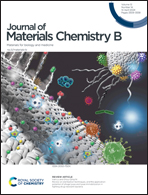Preparation and assessment of agar/TEMPO-oxidized bacterial cellulose cryogels for hemostatic applications†
Abstract
In this work, we have demonstrated agar and oxidized bacterial cellulose cryogels as a potential hemostatic dressing material. TEMPO-oxidized bacterial cellulose (OBC) was incorporated into the agar matrix, improving its mechanical and hemostatic properties. The oxidation of bacterial cellulose (BC) was evidenced by chemical characterization studies, confirming the presence of carboxyl groups. The in vitro blood clotting test conducted on agar/OBC composite cryogels demonstrated complete blood clotting within 90 seconds, indicating their excellent hemostatic efficacy. The cryogels exhibited superabsorbent properties with a swelling degree of 4200%, enabling them to absorb large amounts of blood. Moreover, the compressive strength of the composite cryogels was appreciably improved compared to pure agar, resulting in a more stable physical structure. The platelet adhesion test proved the significant ability of the composite cryogels to adhere to and aggregate platelets. Hemocompatibility and cytocompatibility tests have verified the safety of these cryogels for hemostatic applications. Finally, the material exhibited remarkable in vivo hemostatic performance, achieving clotting times of 64 seconds and 35 seconds when tested in the rat tail amputation model and the liver puncture model, respectively. The experiment results were compared with those of commercial hemostat, Axiostat, and Surgispon, affirming the potential of agar/OBC composite cryogel as a hemostatic dressing material.



 Please wait while we load your content...
Please wait while we load your content...